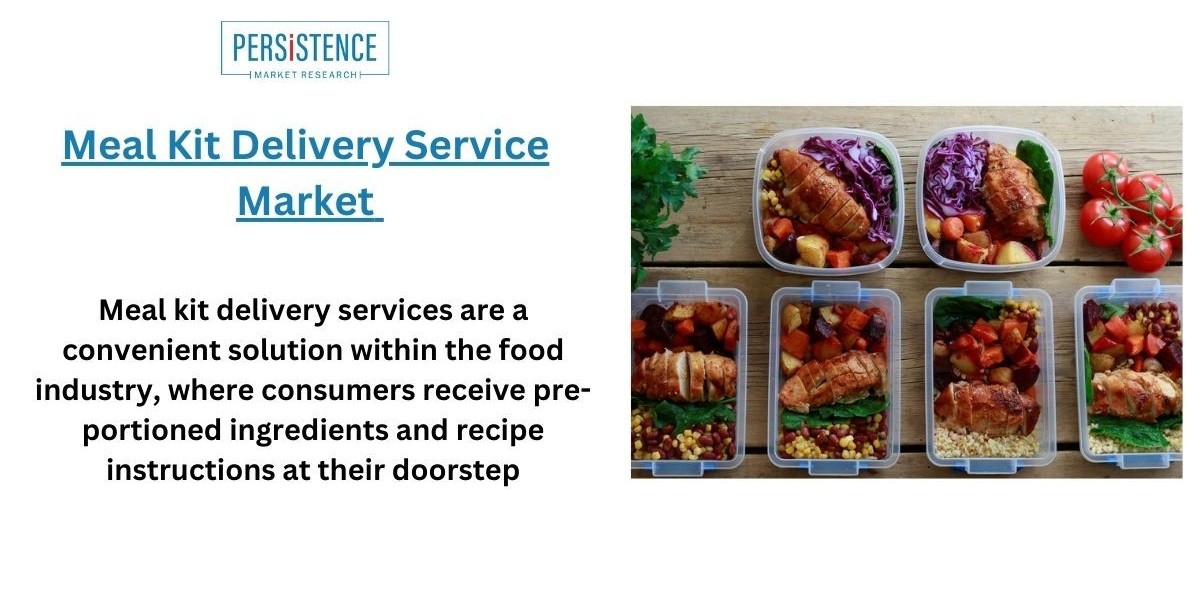Introduction
The global meal kit delivery service market is expected to exhibit substantial growth, with a projected Compound Annual Growth Rate (CAGR) of 13.2%. This expansion is forecasted to propel the market from a valuation of US$18.3 billion in 2023 to an estimated US$43.7 billion by the end of 2030.
Market Overview
Definition: Meal kit delivery services are a convenient solution within the food industry, where consumers receive pre-portioned ingredients and recipe instructions at their doorstep. This emerging market segment aims to simplify the culinary experience by eliminating the need for grocery shopping and meal planning.
Imagine a world where delicious, healthy meals arrive at your doorstep, complete with pre-portioned ingredients and easy-to-follow recipes. This is the reality of the meal kit delivery service market, a rapidly growing industry catering to the needs of busy individuals and families. Gone are the days of frantic grocery store trips and hours spent in the kitchen. Meal kits offer a convenient and efficient solution for those seeking a culinary escape without the hassle.
Consumers can enjoy a variety of chef-curated recipes without the hassle of ingredient procurement. This convenience makes meal kit delivery services appealing to those seeking a balance between homemade meals and busy schedules. The industry prioritizes delivering diverse culinary experiences, fresh ingredients, and customization to cater to evolving consumer preferences.
Several factors contribute to the significant growth of the global meal kit delivery service market:
Market Growth Drivers
- Time-Efficiency: The demand for time-efficient meal solutions is a primary driver. Dual-income households and busy lifestyles prompt individuals to seek nutritious yet easy-to-prepare meal options. Meal kits offer curated recipes with pre-portioned ingredients, reducing meal preparation and grocery shopping time.
- COVID-19 Impact: The COVID-19 pandemic accelerated market growth as more people explored cooking at home due to lockdowns and social distancing measures. Advancements in packaging and supply chain technologies improved ingredient freshness and quality, addressing consumer concerns.
- Sustainability: Growing environmental consciousness contributes to market growth, with meal kit services focusing on eco-friendly packaging and locally sourced ingredients.
In a nutshell, the Persistence Market Research report is a must-read for start-ups, industry players, investors, researchers, consultants, business strategists, and all those who are looking to understand this industry. Get a glance at the report at- https://www.persistencemarketresearch.com/market-research/meal-kit-delivery-service-market.asp
Market Restraints
- Pricing Challenges: Competitive pricing and cost-effectiveness remain significant challenges. Complex logistics, specialized ingredients, and sustainable packaging can increase operational costs, affecting profit margins.
- Intense Competition: Fierce competition in the industry results in congested market conditions. Established and emerging providers must differentiate themselves through pricing, product offerings, and marketing strategies.
- Entry of Conventional Players: The entry of traditional grocery retailers and food delivery platforms intensifies competition and challenges specialized meal kit providers.
Market Opportunities
- Health and Wellness: The growing focus on health and wellness presents an opportunity for meal kit delivery services. Consumers seek nutritious and curated recipes that support their health goals without compromising taste.
- Specialized Dietary Preferences: Customizing meal kits to cater to specialized dietary preferences, such as vegan, vegetarian, or gluten-free diets, can tap into a broader consumer base.
- Technology Integration: Incorporating technology like mobile apps for ordering and nutritional tracking enhances the customer experience, attracting tech-savvy individuals seeking streamlined dietary solutions.
Market Segmentation
Leading Market Segment: The heat-and-eat segment is expected to dominate the meal kit delivery service market, catering to consumers who prioritize convenience. These pre-prepared dishes require minimal effort to reheat, aligning with busy modern lifestyles.
Regional Markets: North America holds the largest market share due to a culture of convenience-driven consumption, busy lifestyles, and a strong e-commerce infrastructure. South Asia and Oceania are witnessing rapid growth due to emerging economies, evolving consumer preferences, and an expanding middle class.
Competitive Intelligence and Business Strategy
Prominent market contenders like Blue Apron, HelloFresh, and Home Chef enhance their market presence through:
- Customer-Centric Solutions: Meeting customer preferences by offering a wide range of recipes that accommodate various flavors and dietary restrictions.
- Strategic Alliances: Establishing partnerships with grocery retailers and esteemed chefs to expand customer base and access additional distribution channels.
- Technology Integration: Investing in data analytics, mobile apps, and user-friendly interfaces to improve the overall customer experience.
- Personalized Recommendations: Providing tailored recommendations and reliable order tracking to enhance customer satisfaction.
Key Company Developments
- New Product Launch: Home Chef introduced a Family menu to cater to families seeking convenient and easy-to-prepare recipes, enhancing customer satisfaction and expanding the meal kit market.
- Expansion into New Markets: Factor entered the Canadian market with its ready-to-heat meal delivery service, addressing the demand for convenient and nutritious dining alternatives, and expanding its global presence.
In conclusion, the meal kit delivery service market offers substantial growth opportunities driven by changing consumer preferences, health consciousness, and convenience-oriented lifestyles. Industry players must continuously adapt, differentiate themselves, and leverage technology to thrive in this dynamic and competitive landscape.
Find below related reports:
Meal Kit Delivery Service Market Size, Share & Trends Report, 2030
Zero Liquid Discharge (ZLD) Market Size & Growth Report, 2030
About Persistence Market Research:
Business intelligence is the foundation of every business model employed by Persistence Market Research. Multi-dimensional sources are being put to work, which include big data, customer experience analytics, and real-time data collection. Thus, working on “micros” by Persistence Market Research helps companies overcome their “macro” business challenges.
Persistence Market Research is always way ahead of its time. In other words, it tables market solutions by stepping into the companies’/clients’ shoes much before they themselves have a sneak pick into the market. The pro-active approach followed by experts at Persistence Market Research helps companies/clients lay their hands on techno-commercial insights beforehand, so that the subsequent course of action could be simplified on their part.
Contact
Persistence Market Research
Teerth Technospace, Unit B-704
Survey Number - 103, Baner
Mumbai Bangalore Highway
Pune 411045 India
Email: sales@persistencemarketresearch.com
Web: https://www.persistencemarketresearch.com
LinkedIn | Twitter








